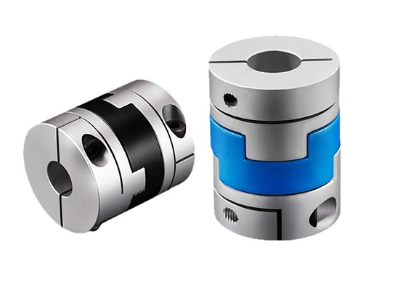
Encyclopedia
 current location: Home > News > Encyclopedia
current location: Home > News > Encyclopedia
 Release time:2025-09-13
Release time:2025-09-13 page views:
page views: Aluminum Alloy Coupling
An aluminum alloy coupling is a mechanical component widely used in industrial drive systems to connect two shafts (driving and driven) for transmitting torque and motion while compensating for possible misalignments.

Lightweight: This is the most significant advantage. Its density is much lower than steel (about one-third of steel), significantly reducing rotational inertia. It is particularly suitable for high-speed applications requiring quick start-stop or frequent reversals, such as servo systems, reducing motor load and improving system response.
Non-Magnetic: Aluminum alloy is non-ferromagnetic, making it essential in applications where magnetic interference must be avoided, such as MRI equipment and semiconductor manufacturing devices.
Corrosion Resistance: Aluminum alloy forms a dense oxide layer on its surface, providing good resistance to atmospheric and general chemical corrosion, making it suitable for humid or corrosive environments.
Excellent Machinability: Aluminum is easy to cut and shape, allowing for the production of complex and high-precision couplings at relatively low costs.
Good Electrical Conductivity: In applications where bypassing current (to prevent bearing erosion) is necessary, aluminum alloy couplings can act as conductors.
Lower Strength and Hardness: Compared to high-quality alloy steel, aluminum alloy has lower strength, stiffness, and fatigue strength. It is unsuitable for heavy-duty industrial applications involving extremely high torque or severe impact loads.
Poor Temperature Resistance: The mechanical properties of aluminum alloy significantly degrade at elevated temperatures. Its continuous operating temperature typically should not exceed 100°C–120°C, far below that of stainless steel or steel couplings.
Creep Tendency: Under sustained high loads, aluminum alloy is more prone to creep (slow plastic deformation) than steel, potentially leading to preload relaxation or connection failure.
Average Wear Resistance: Compared to hardened steel, the wear resistance of key parts such as keyways and threads in aluminum alloy is relatively poor.
Aluminum alloy couplings come in various designs to meet different needs. The most common types include:
Jaw Coupling (Spider Coupling)
Structure: Two aluminum alloy hubs (with claws) clamp an elastomer spider (typically made of polyurethane or rubber).
Features: Good vibration damping, cushioning, and misalignment compensation capabilities. Available in a wide range of torsional stiffness options, making it a versatile and economical choice.
Diaphragm Coupling
Structure: Consists of two aluminum alloy hubs connected by a set of multilayer stainless steel diaphragms via bolts.
Features: Zero backlash, high torsional rigidity, maintenance-free, and high-temperature resistance. Ideal for high-precision servo applications, such as machine tools, robotics, and aerospace. It represents the high-performance end of aluminum alloy couplings.
Bellows Coupling
Structure: Made entirely of aluminum alloy, with a thin-walled bellows as the middle section.
Features: Zero backlash, high torsional rigidity, and compensation for angular and radial misalignment. Often used in small to medium torque precision motion control applications, such as encoders and stepper motors.
Oldham Coupling
Structure: Two aluminum alloy hubs sandwich a cross-shaped slider made of engineering plastic (e.g., POM) or alloy.
Features: Compact, low-cost, and capable of compensating for significant radial misalignment. However, at high speeds, centrifugal force may cause backlash, and wear resistance depends on the slider material.
Rigid Coupling
Structure: Entirely made of an aluminum alloy sleeve.
Features: No misalignment compensation capability, requiring high alignment accuracy. Used solely for torque transmission, with advantages such as ultra-low cost, zero backlash, and high rigidity.
Torque: Calculate the rated torque and maximum torque (peak torque) of the application. The coupling’s rated torque must exceed the rated operating torque and withstand peak torque impacts.
Speed: The coupling’s maximum allowable speed must be higher than the system’s maximum operating speed. Aluminum alloy couplings typically have high-speed limits due to their lightweight nature.
Misalignment Compensation: Evaluate possible parallel misalignment, angular misalignment, and axial displacement in the system. Choose a coupling type with corresponding compensation capabilities.
Backlash: Precision positioning systems (e.g., robotics, CNC) require zero backlash. Diaphragm or bellows couplings should be selected. Non-precision drives can tolerate some backlash.
Stiffness Issues:
Torsional Stiffness: The ability to resist torsional deformation. High stiffness improves servo system response and positioning accuracy.
Axial/Radial Stiffness: Affects the reaction forces generated when the coupling compensates for misalignment.
Environment: Consider temperature, humidity, and the presence of oil, chemicals, or magnetic interference.
Installation and Space: Consider shaft diameter, keyway or clamp-type connections, and the allowed outer diameter and length of the coupling.
Servo and Stepper Motor Systems: This is the largest market for aluminum alloy couplings, especially diaphragm and bellows types.
General Industrial Machinery: Light to medium-duty drives in packaging, textile, printing, and food processing machinery.
Precision Instruments: Measuring equipment, optical instruments, encoders.
Semiconductor and Electronics Manufacturing Equipment: Leveraging its non-magnetic properties.
Aerospace: Used in various auxiliary drive systems, leveraging its lightweight and high reliability.
Aluminum alloy couplings, with their lightweight, non-magnetic, corrosion-resistant, and machinable properties, dominate the modern industrial drive field for small to medium power, high-speed, and high-precision applications. When selecting, it is essential to carefully weigh their limitations in strength and temperature resistance and choose the most suitable type (e.g., diaphragm for high precision, jaw for general purpose) based on specific application needs (torque, speed, precision, environment).
For most non-heavy-duty automation equipment, aluminum alloy couplings are an ideal choice for achieving efficient and precise power transmission.


Hotline:
+8615066616606 hq@hqcplg.com
hq@hqcplg.com